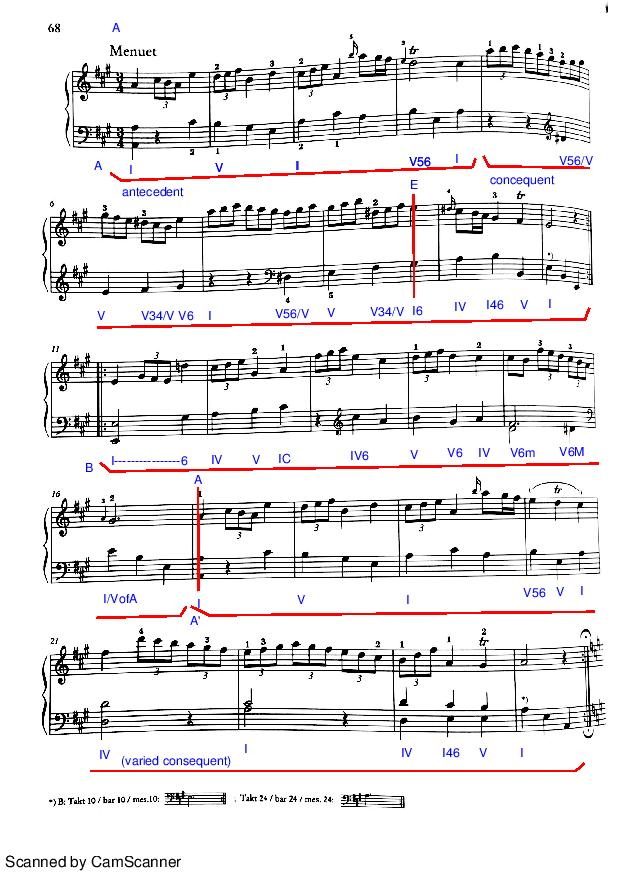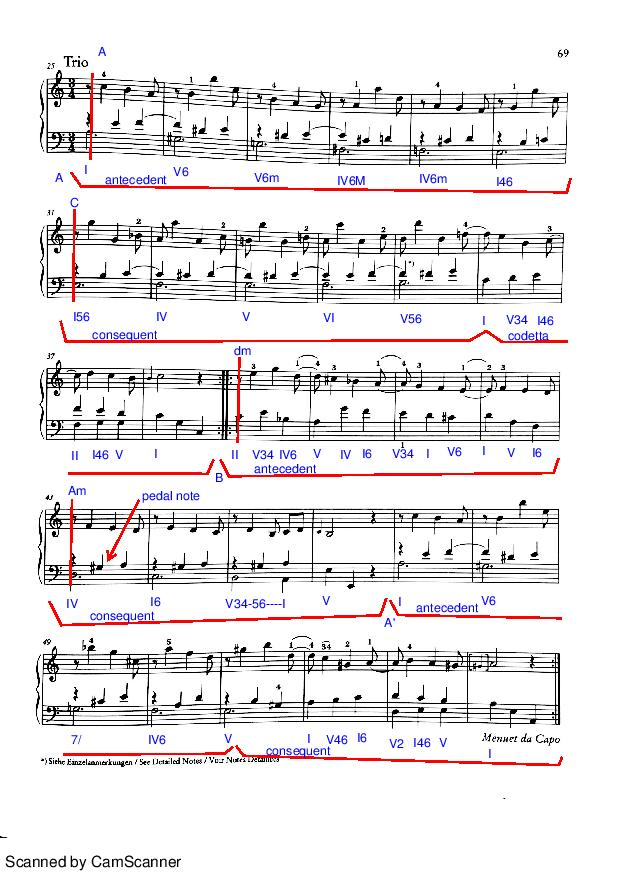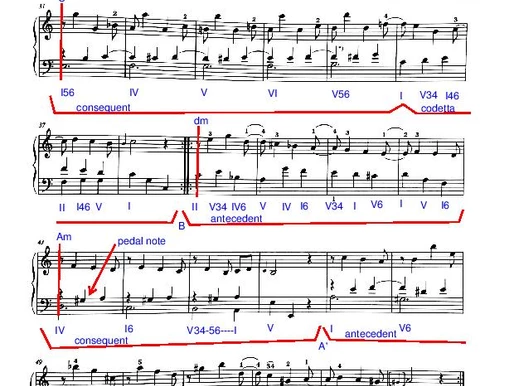Haydn Sonatas, Uncategorized
Haydn Hob. XVI12 – Second Movement
Second Movement – Minuet and trio
Menuet
This Menuet is written following an A-B-A’ structure. “A” is substantially varied at the end of the piece.
A’s antecedent features:
In the treble:
- Rhythmically: the combination of triplets and crotchets
- Melodically: A line that always portrays the chord through an arpeggiated melodic contour.
In the bass
A simple arpeggiated melodic line
In the combined texture
A contrapuntal interaction that features double notes on each b

at. The treble is always ornamented while the bass plainly exposes the naked arpeggio.
B’s antecedent
The contrapuntal texture remains the same as in the antecedent. The main variation is experienced by the treble, where the “leapy” melodic contour is replaced by a smooth scalistic one. The bass also modifies its behaviour and showcases scales in augmentation if compared to the treble ones.
In terms of the phrasing, we are facing what would be considered a sentence according to William Caplin’s classification. The structure of this particular sentence is quite rich. We encounter a 4 bar long antecedent which is then followed by a 6 bar consequent, ending in a codetta -bars 9 and 10-. “A” therefore modulates to the dominant as expected.
“B” constitutes a very shy variation of “A”’s antecedent, ending in a codetta similar to what happens at “A’”s consequent.
“A’” ‘s antecedent is the same as “A”, while its compressed consequent is worked out as a stretched Perfect Authentic Cadence, ending in codetta. This cadencial approach to the harmonic progression allows the easy compression of the consequent while it increases the intensity toward the ending of the movement in the tonic.
Trio

This trio follows an A-B-A’ structure with deeply varied “A’”.
Extremely lyrical in character, it main features the off-beat in the treble. The melodic contour in the treble is built up around a succession of step-wise movements ornamented through repetitions and escapatorias -e.g. second crotchet bar 2-. The bass follows a strict descending scale in the antecedent and an ascending one in the consequent. The codetta continues with the same behaviour but in diminution; the latter producing an acceleration of the harmonic rhythmic, highly desirable when approaching the cadence section.
Antecedent and consequent are balanced through this ascending and descending attitudes in the bass and treble. In both cases -antecedent and consequent- the focal points move in parallel through both the bass and treble. The passage is balanced direction-wise between antecedent and consequent.
“B” gains in expression by eliminating the rests in its antecedent and featuring an almost completely parallel continuous and dual descending scale from bars 38 -43. In spite of “B” being closely related to “A”’s antecedent from the beginning, this relation becomes even more evident in its consequent. It continues featuring a descending scale through its focal points, but this time the design is almost the same we find in “A”’s antecedent. We can highlight the use of a pedal note on G# in the bass’ middle voice, which pulls quite efficiently towards the dominant at bar 46.
Harmonically speaking, it is quite interesting to see how the full movement is written in Am with a strong tendency towards C. These keys are fairly distant from A, particularly C; which is only related to A by being the relative major of A’s modal counterpart. This relation gives a very refreshing harmonic glow to this movement.
In opposition to “A”, “A’” is very regular. With equally sized antecedent and consequent, it manages to powerfully re-establish the tonic through the use of a “summarizing” diminished seventh chord at bar 49. This strategy helped Haydn to reach the V in time -by the beginning of “A’”’s consequent- and incorporate a perfect authentic cadence bar 53.
#JuanRezzuto #Haydnproject #HaydnProject

